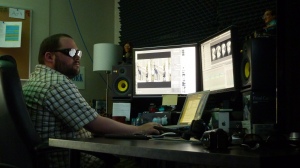Shooting a 3D documentary: anaglyphic test footage – 2 Canon 7Ds on a side-by-side rig
As I’ve mentioned, we’re testing several camera systems out to decide what to use to film our first 3D documentary. We’ve seen promising footage out of our A cam system – an Iconix sensor system with Meuser Optik lenses on a side-by-side rig.
Now our stereographer, Sean White, has brought in B roll he shot with our C cam system: two Canon 7D DSLRs on a side-by-side rig.
Happy to say it’s not looking bad either.
Need a pair of the old school anaglyphic glasses for this one:
There’s only one problem: some of the backgrounds are diverging past our broadcasters’ specs.
So now we’ll have to experiment with different interaxials until we fix the issue.
In the field – the demo of a condemned sports stadium in Salvador, Brazil for the explosive demolition series Blowdown – this system will be used to capture establishing shots of the structure and, of course, its implosion.
Here’s an earlier video of Sean, walking though the setup.
We’re also honing how to capture our time lapses with this system – details to come.


